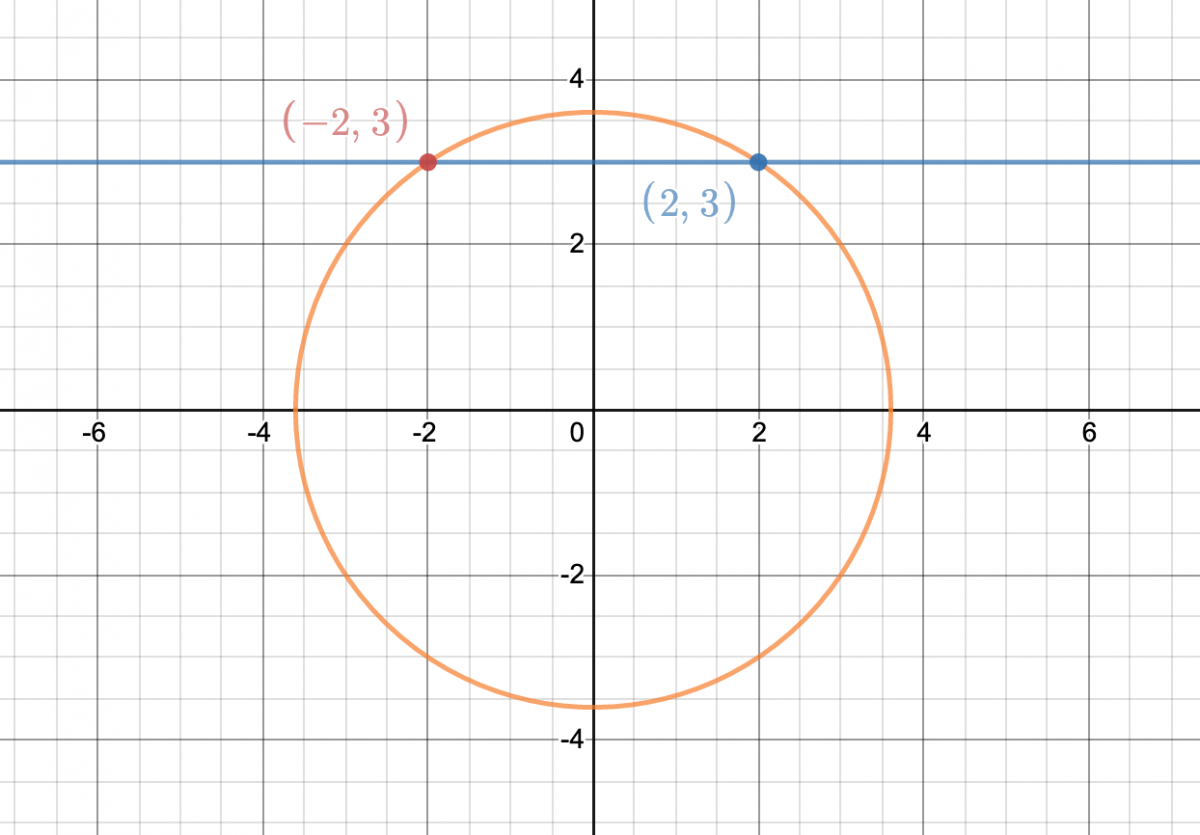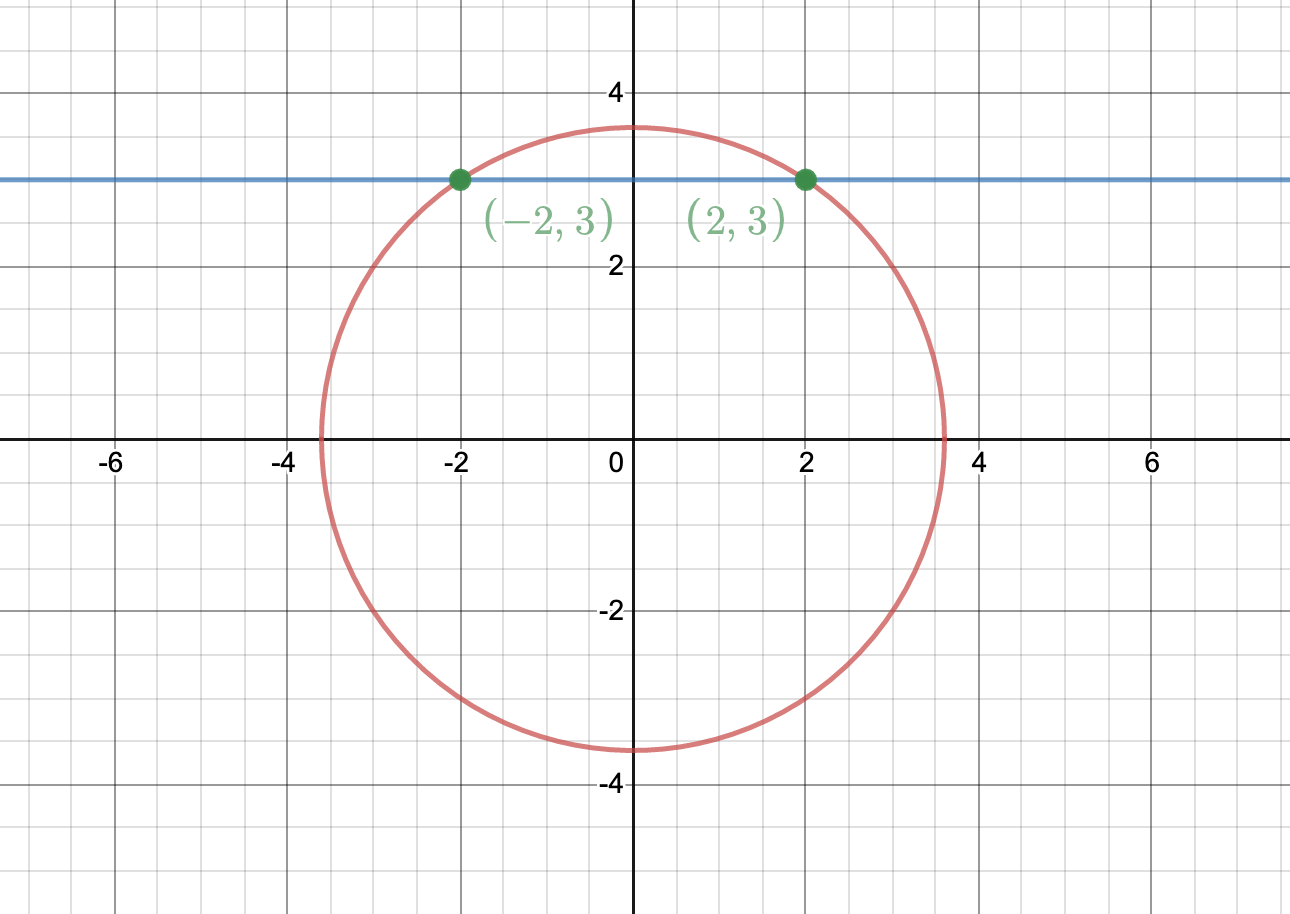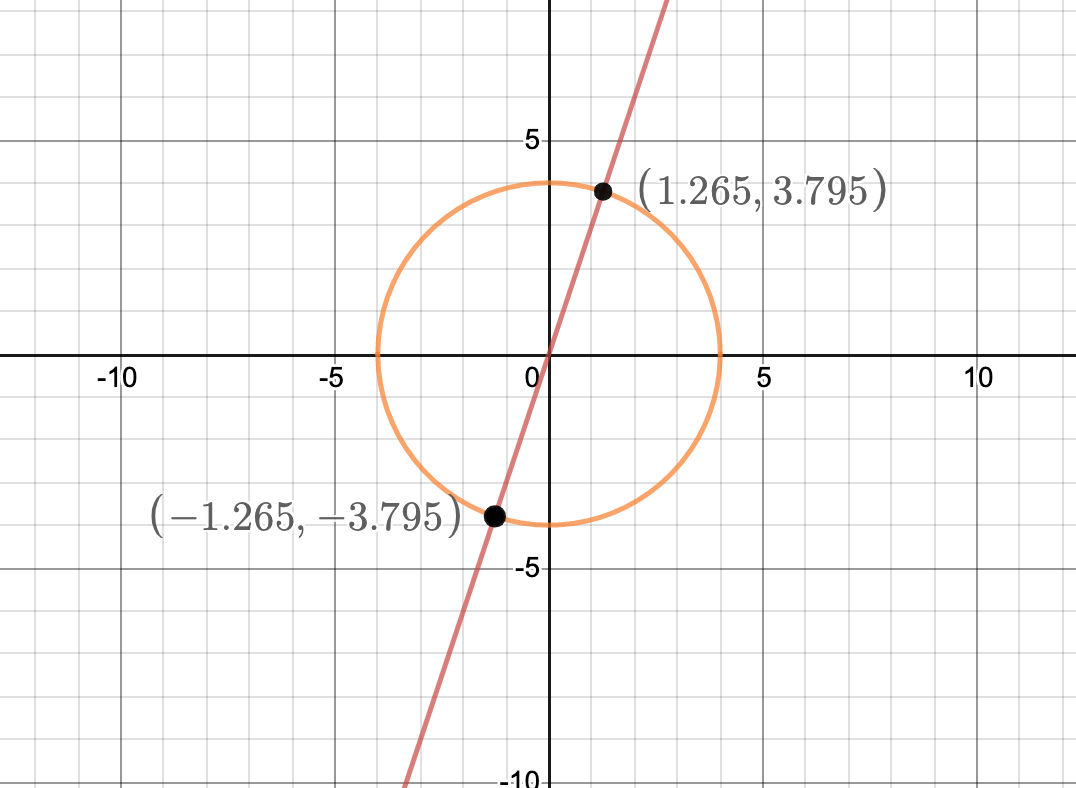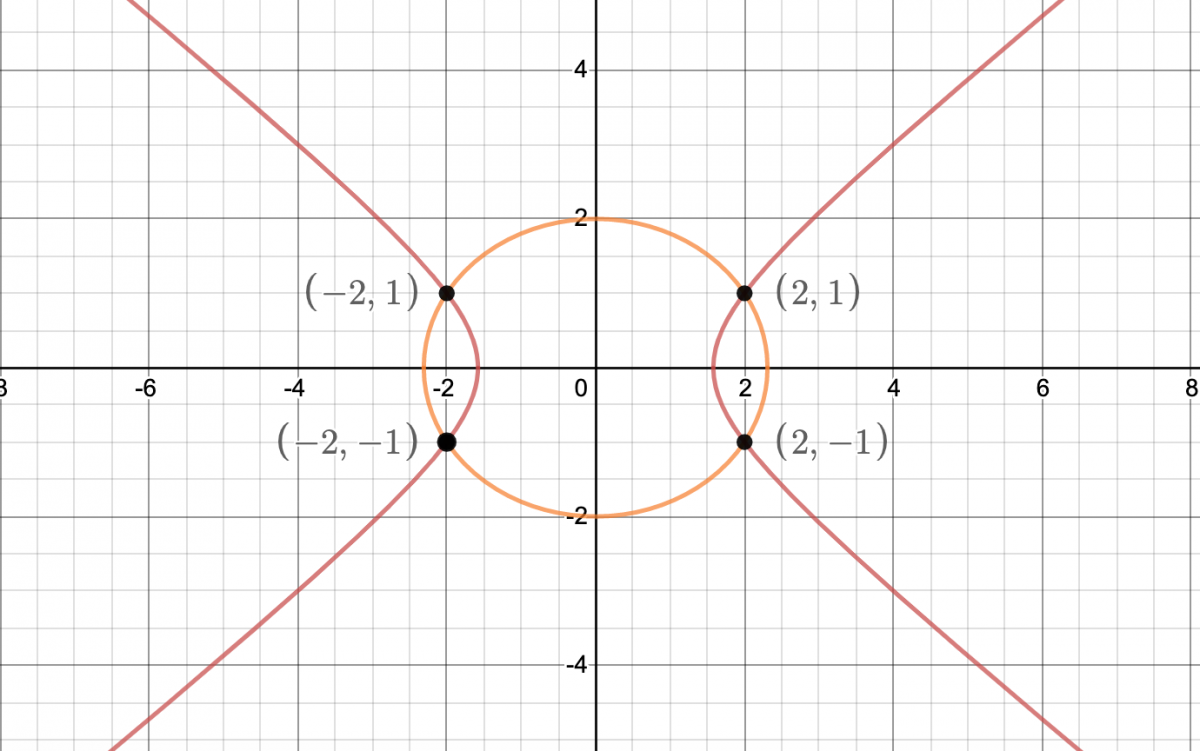Hi Everyone!
On this page you will find some material about Lesson 12. Read through the material below, watch the videos, and follow up with your instructor if you have questions.
Lesson 12: Nonlinear Systems of Equations in Two Variables
Table of Contents
Resources
In this section you will find some important information about the specific resources related to this lesson:
- the learning outcomes,
- the section in the textbook,
- the WeBWorK homework sets,
- a link to the pdf of the lesson notes,
- a link to a video lesson.
Resources
Learning Outcomes.
- Solve a system of nonlinear equations in two variables.
- Give a geometric interpretation to solving a system of nonlinear equations in two variables.
Topic. This lesson covers Section 9.4: Nonlinear Systems of Equations in Two Variables.
WeBWorK. There is one WeBWorK assignment on today’s material:
NonLinearSystems
Lesson Notes.
Video Lesson.
Video Lesson 12 (based on Lesson 12 Notes)
Warmup Questions
These are questions on fundamental concepts that you need to know before you can embark on this lesson. Don’t skip them! Take your time to do them, and check your answer by clicking on the “Show Answer” tab.
Warmup Question 1
Solve for $x$:
$$x^2=8$$
Show Answer 1
$$x^2=8$$
$$x=\pm\sqrt{8}$$
$$x=\pm2\sqrt{2}$$
Warmup Question 2
Solve for $x$:
$$x^2+x-6=0$$
Show Answer 2
$$x^2+x-6=0$$
$$(x-2)(x+3)=0$$
$$x=2 \quad\text{ or } \quad x=-3$$
Review
If you are not comfortable with the Warmup Questions, don’t give up! Click on the indicated lesson for a quick catchup. A brief review will help you boost your confidence to start the new lesson, and that’s perfectly fine.
Need a review? Check
Quick Intro
This is like a mini-lesson with an overview of the main objects of study. It will often contain a list of key words, definitions and properties – all that is new in this lesson. We will use this opportunity to make connections with other concepts. It can be also used as a review of the lesson.
A Quick Intro to Nonlinear Systems of Equations
in Two Variables
Key Words. System, nonlinear equation, solution to a system.
Consider a circle with center at $(0,0)$ and radius $\sqrt{13}$. Now consider the line $y=3$.

The graph shows that the circle intersects the line at $(-2,3)$ and $(2,3)$. In other words, the system formed by the equation of the circle and the equation of the line
$$\begin{cases}x^2+y^2=13\\y=3\end{cases}$$
has two solutions: $(-2,3)$ and $(2,3)$.
How can we find these two points algebraically?
In general, how many intersection points can a circle and a line have?
Video Lesson
Many times the mini-lesson will not be enough for you to start working on the problems. You need to see someone explaining the material to you. In the video you will find a variety of examples, solved step-by-step – starting from a simple one to a more complex one. Feel free to play them as many times as you need. Pause, rewind, replay, stop… follow your pace!
Video Lesson
A description of the video
In this video you will see how to solve
- $\begin{cases} x^2+y^2=4 \\ y=-x+1\end{cases}$
- $\begin{cases} 2x^2+3y^2=5 \\ y=x^2\end{cases}$
- $\begin{cases}3x^2+2y^2=5\\x^2+2y^2=3\end{cases}$
Try Questions
Now that you have read the material and watched the video, it is your turn to put in practice what you have learned. We encourage you to try the Try Questions on your own. When you are done, click on the “Show answer” tab to see if you got the correct answer.
Try Question 1
Solve $$\begin{cases}x^2+y^2=13\\y=3\end{cases}$$
Show Answer 1
$$\begin{cases}x^2+y^2=13\\y=3\end{cases}$$
First, we observe that the equation $y=3$ means that all solutions (if any) have the second coordinate equals 3. By substituting $y=3$ into $x^2+y^2=13$, we obtain
$$x^2+3^2=13$$
$$x^2+9=13$$
$$x^2=4$$
$$x=-2\quad\text{ or } \quad x=2$$
The solution set is $\{(-2,3),(2,3)\}$.

Try Question 2
Solve $$\begin{cases}x^2+y^2=16\\ y=3x \end{cases}$$
Show Answer 2
$$\begin{cases}x^2+y^2=16\\ y=3x \end{cases}$$
Substitute $y=3x$ into $x^2+y^2=16$ and get:
$$x^2+(3x)^2=16 $$$$x^2+9x^2 = 16 $$$$ 10x^2 = 16 $$ $$ x^2 = \dfrac{16}{10}$$$$ x^2 = \dfrac{8}{5}$$
$$ x = \pm \sqrt{\dfrac{8}{5}} $$
$$ x=\pm \dfrac{2\sqrt{2}}{\sqrt{5}}$$
$$ x=\pm \dfrac{2\sqrt{10}}{5} $$
$\bigstar$ When $x=\dfrac{2\sqrt{10}}{5}$,
$$y = 3x=3\cdot \dfrac{2\sqrt{10}}{5} = \dfrac{6\sqrt{10}}{5}.$$
$\bigstar$ When $x=- \dfrac{2\sqrt{10}}{5}$,
$$y = 3x=3\cdot\left(- \dfrac{2\sqrt{10}}{5}\right) = -\dfrac{6\sqrt{10}}{5}.$$
The solution set is $\left\{\left(\dfrac{2\sqrt{10}}{5}, \dfrac{6\sqrt{10}}{5}\right), \left(-\dfrac{2\sqrt{10}}{5}, -\dfrac{6\sqrt{10}}{5}\right)\right\}$.
We have $\dfrac{2\sqrt{10}}{5}\approx 1.265$ and $\dfrac{6\sqrt{10}}{5}\approx 3.795$. Geometrically, we have

WeBWorK
You should now be ready to start working on the WeBWorK problems. Doing the homework is an essential part of learning. It will help you practice the lesson and reinforce your knowledge.
WeBWorK
It is time to do the homework on WeBWork:
NonLinearSystems
When you are done, come back to this page for the Exit Questions.
Exit Questions
After doing the WeBWorK problems, come back to this page. The Exit Questions include vocabulary checking and conceptual questions. Knowing the vocabulary accurately is important for us to communicate. You will also find one last problem. All these questions will give you an idea as to whether or not you have mastered the material. Remember: the “Show Answer” tab is there for you to check your work!
Exit Questions
- What is the difference between a linear and a non-linear equation?
- What does it mean to solve a system of equations?
- What is the graphical description of solving a system of non-linear equations?
- How can this be helpful in solving the system?
- Must we check our answers?
- How is this similar or different from solving a system of two linear equations?
$\bigstar$ Solve the system of equations $$\begin{cases}3x^2 + 4y^2 = 16\\ 2x^2-3y^2=5\end{cases}$$
Show Answer
$$\begin{cases}3x^2 + 4y^2 = 16\\ 2x^2-3y^2=5\end{cases}$$
We will use the Addition Method. Multiply the first equation by -2 and the second equation by 3:
$$\begin{cases}-6x^2 -8y^2 = -32 \\ 6x^2-9y^2=15 \end{cases}$$
By adding these equations, we eliminate the $x^2$ term:
$$-17y^2=-17$$
Now we solve for $y$:
$$y^2=1$$
$$y=\pm 1$$
$\bigstar$ Substitute $y=1$ into the first original equation and solve for $x$:
$$3x^2 + 4y^2 = 16$$
$$3x^2 + 4(1)^2 = 16$$
$$3x^2 + 4 = 16$$
$$3x^2 = 12$$
$$x^2 = 4$$
$$ x = \pm 2$$
$\bigstar$ Substitute $y=-1$ into the first original equation and solve for $x$:
$$3x^2 + 4y^2 = 16$$
$$3x^2 + 4(-1)^2 = 16$$
$$3x^2 + 4 = 16$$
$$3x^2 = 12$$
$$ x^2 = 4$$
$$x = \pm 2$$
The solution set is $\{(2,1),(-2,1), (2,-1),(-2,-1)\}$.
Geometrically, we have

Need more help?
Don’t wait too long to do the following.
- Watch the additional video resources.
- Talk to your instructor.
- Form a study group.
- Visit a tutor. For more information, check the tutoring page.


